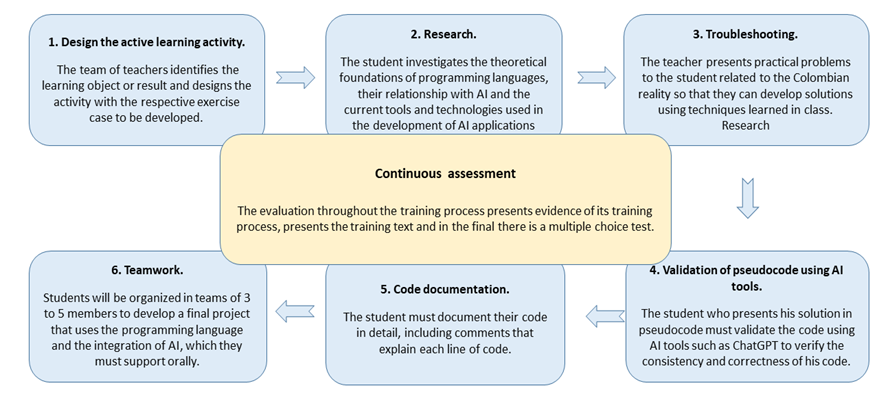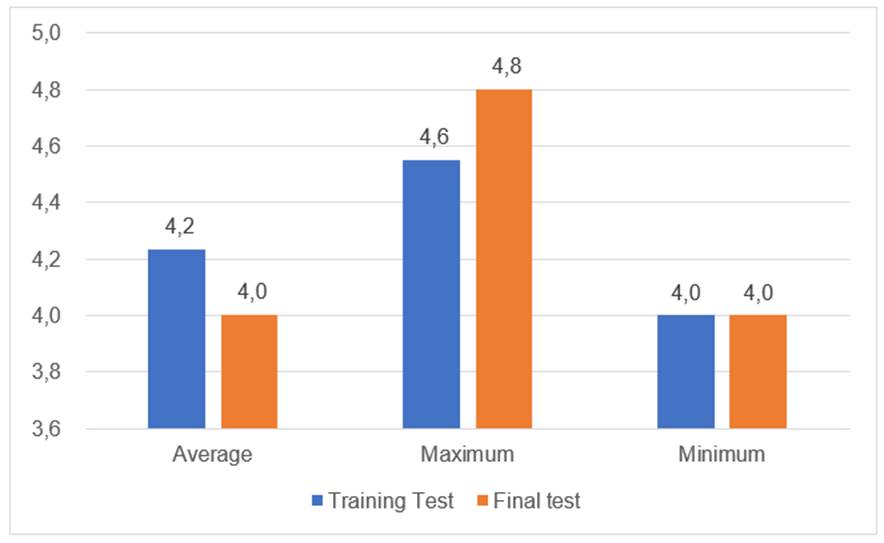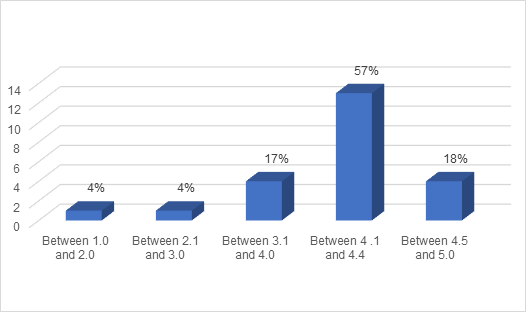I. Introduction
In the current era, Artificial Intelligence (AI) is gaining strength, and it is increasingly important for university students to develop skills in handling and leveraging the tools that involve this technology and integrate them into their formative and professional activities. On the other hand, in the field of computer programming, specifically in Object-Oriented Programming (OOP), which is a crucial subject in the education of systems engineering and computer science programs, the difficulty of teaching has been evident due to the abstract nature of this topic. Therefore, the research project Biometric Analysis of Human-Computer Interaction between Students and Educational Content in Virtual Mode using Artificial Intelligence Tools (ANABIO), which aims to enhance the virtual learning experience by applying biometric analysis techniques and Artificial Intelligence tools to engineering students in the field of programming. It begins with an analysis of the use of AI in educational environments and presents an Active Learning Plan (ALP) that integrates research, logical-mathematical skills, reading and writing comprehension, and OOP supported by artificial intelligence tools. The results presented are the outcome of the ANABIO project.
This article proposes an active learning approach to teaching OOP, involving students in practical activities and collaborative problem-solving. The proposed approach is based on an ALP that includes various activities and resources to guide the learning process, supported by artificial intelligence tools. In the specific case of learning a computer programming language, implementing an active learning plan is one of the ways in which students can acquire these skills. However, achieving this requires changing traditional teaching methods and adopting this learning approach, which includes problem-solving and collaboration supported by AI tools.
For the development of the research article, there exists a three-section structure as outlined below:
1) Challenges and Opportunities in the Era of AI. AI presents challenges and opportunities in higher education. On the one hand, students need to acquire skills in handling this technology to be prepared for the future job market. On the other hand, ethical and social concerns related to its use must be considered. Educators must clearly understand the benefits and limitations of AI to integrate it effectively into the classroom.
2) Active Learning Approach in Teaching Programming Languages. The active learning approach in teaching programming languages involves problem-solving and collaboration. Students must face practical challenges and work in teams to solve them. Additionally, AI tools such as ChatGPT should be integrated to validate pseudocode and code documentation. This approach enables students to acquire practical skills and develop their ability to apply technology to real-world situations.
3) Active Learning Plan for Learning Programming Languages. The ALP focuses on active learning, problem-solving, teamwork, and formative and summative assessment. Leveraging AI tools like ChatGPT can be highly beneficial in validating pseudocode and generating multiple-choice questions. The ALP starts by verifying the opportunities and needs of an efficient learning process and then focuses on supporting AI tools and guiding students in the proper use of ChatGPT and text analysis platforms.
According to data from Colombia's Ministry of National Education, in 2020, the country's net coverage rate in higher education was 57.9%, meaning approximately 3 out of 5 young adults are enrolled in higher education institutions [1]. Additionally, the report indicates that the dropout rate in higher education in Colombia is 11.6%, with one in every 10 students leaving their studies before completion. On the other hand, according to a perception survey on educational quality conducted by the Ministry of National Education in 2021 [2], 57.2% of higher education students consider the quality of their education to be good or very good, while 25.5% consider it to be average.
Notably, 69.4% of students consider the quality of virtual education offered by their institutions during the pandemic to be good or very good. This information indicates that there are still significant challenges regarding the quality of higher education in Colombia, and there are opportunities to improve it through the implementation of innovative pedagogical strategies, such as the use of AI tools and the application of active learning approaches like the proposed ALP.
It must be taken into account that AI is drastically changing how companies and industries operate, making AI-related skills increasingly necessary in the job market. For this reason, higher education students must acquire the necessary skills to navigate and harness the power of AI.
In this regard, the required skills not only refer to the ability to use AI tools but also to understand the fundamentals and applications of AI, as well as its ethical implications. Students should learn how AI can aid in decision-making, problem-solving, and task automation, but they should also be able to identify the limitations and potential biases of AI, distinguishing between the proper use and misuse of an AI-centered tool.
AI is also creating new opportunities in the job market, as it enables the creation of new positions related to programming, data analysis, and AI project management. Students who are prepared to seize these opportunities will have an advantage in the job market and will be able to contribute to the development of new technologies and innovative solutions. Therefore, educators are responsible for providing students with the necessary skills to navigate and harness the power of AI, not only to succeed in the job market but also to enable them to contribute to the development of new technologies and innovative solutions that can have a positive impact on society.
It is important to note that disruptive trends have been implemented since 2018 [3], where in a virtual educational context, records containing information on the activities carried out by students at a specific time were analyzed. With this, the analysis of logs in academic terms was addressed, characterizing the logs to measure a set of variables related to academic behavior and constructing a database with this characterization. Subsequently, through a self-organizing map network, the collected information was interpreted, enabling the classification of students based on their academic behavior and their behavior on the Moodle platform, generating early alerts that allowed for increased retention and persistence rates.
On the other hand, in 2023, the scientific research project "Biometric Analysis of Human-Computer Interaction Between Students and Virtual Educational Content Using Artificial Intelligence Tools - ANABIO" began at ECCI University. The ANABIO project aims to enhance the virtual learning experience by applying biometric analysis techniques and artificial intelligence tools. This will be achieved by capturing and analyzing students' biometric and emotional data while they interact with virtual educational content. This analysis will enable the adaptation of educational content to each student's individual needs and provide specific and personalized feedback to both students and teachers in real time for each subject. Furthermore, this research serves as the foundation for academic content that allows personalized and adaptive learning, integrating new approaches and active learning methodologies in the teaching and learning of programming.
II. Methodology
An in-depth analysis of the challenges and opportunities of AI in education is conducted, along with the active learning approach in education using the flipped classroom methodology [4] for teaching object-oriented programming languages. Based on this documentary analysis, a training methodology centered on the active learning plan (ALP - POO) is developed [5]. The methodology is structured into three phases:
A. Phase 1: Challenges and Opportunities in the Era of AI
In teaching object-oriented programming in higher education, there are several challenges and opportunities in the era of AI. One challenge is to ensure that students have a solid understanding of the fundamental concepts of POO before moving on to the application of AI tools in programming. Furthermore, it is essential to ensure that students understand how to apply the principles of POO to develop effective AI solutions.
A key opportunity in teaching OOP is the integration of artificial intelligence tools in the classroom to enhance students' understanding of language syntax and programming logic, as well as their ability to create effective solutions to real-world problems [6]. For example, using machine learning algorithms and natural language processing tools can help students better comprehend the relationship between the POO structure and the decision-making process in AI.
A challenge is to equip students with the necessary skills to work in constantly evolving AI environments. This involves staying updated on the latest AI trends and being able to apply them effectively in programming projects.
B. Phase 2: Active Learning Approach in Teaching
By integrating AI tools in the classroom, the students' capabilities to create effective AI solutions can be significantly enhanced, as suggested by the works of [7] and [8]. It also allows for the development of high-quality software development competencies.
Considering the opportunities that AI presents, the active learning approach in teaching object-oriented programming languages is fundamental to preparing students for the current job market, where object-oriented programming is a highly valued skill in the technology industry. This approach embraces the ideas of active learning in programming education [9].
By adopting an active learning approach, students not only learn the theoretical concepts of object-oriented programming but also have the opportunity to apply them in problem-solving and practical projects. This enables them to gain hands-on experience in object-oriented programming and understand how theoretical concepts are applied in real-world situations [10].
Furthermore, the active learning approach fosters collaboration and teamwork [9], which are essential in the technology work environment. Students have the opportunity to work together on projects and problems, allowing them to develop communication and collaboration skills and learn how to work as a team to achieve common goals.
However, teaching object-oriented programming also presents some challenges in the era of artificial intelligence. With the rapid evolution of technology, it is crucial that teaching programs are updated with the latest advancements and trends in object-oriented programming and that AI tools are integrated into the classroom. Addressing gender and diversity gaps in technology and promoting inclusivity and equal opportunities in the classroom is also important for object-oriented programming teaching programs [11].
In summary, the active learning approach in teaching object-oriented programming languages is crucial to preparing students for the current job market. However, the challenges of teaching programming must not be overlooked, and efforts should be made to foster inclusion and equal opportunities in the classroom [12].
C. Phase 3: Active Learning Plan for Learning Programming Languages
The proposal of the active learning plan for object-oriented programming is more relevant than ever [13]. While the project focuses on programming, the active learning plan can be implemented in teaching any language and any development methodology since the ALP is essential for learning programming languages, as it allows students to engage in their learning process [14] actively.
The ALP emphasizes problem-solving, collaboration, and the integration of AI tools in the classroom. By following the ALP, students can investigate and explore the subject in-depth, enabling them to understand concepts better and develop practical skills. Furthermore, the ALP enables students to work in teams, allowing them to develop collaboration and communication skills. This is significant as programming is often carried out in teams in the workplace. Working in teams allows students to share knowledge and skills, helping them better grasp concepts and enhance their problem-solving abilities.
D. Proposal for an Active Learning Plan Integrating AI in Programming Education
After analyzing the opportunities presented by AI, the ALP was formulated and applied to learning programming languages, enabling students to engage actively in an efficient software development process. The ALP emphasizes problem-solving, collaboration, and the integration of AI tools in the classroom. By following an ALP, students can delve deeply into the subject, enabling a better understanding of concepts and the development of practical skills.
A set of activities is proposed to implement the active learning plan in teaching programming languages with AI integration, as visualized in Figure 1.
The ALP provides a framework for effectively teaching programming languages with AI integration, fostering collaboration and problem-solving skills. Additionally, the use of AI tools for pseudocode validation and code documentation improves the quality and accuracy of the code produced by students.
III. Results
The ALP was tested with a web application development course, which had 23 students from systems engineering. The active learning plan, which integrated AI, was implemented by applying the flipped learning methodology, and the following results regarding the impact on the learning process in the course were achieved.
The quantitative analysis was conducted using Cronbach's Alpha (α), a coefficient used to measure the reliability of a measurement scale or test. Reliability is a concept with several definitions, but in general terms, it can be defined as the absence of measurement errors in a test or as the precision of its measurement. Figure 2 shows the consolidated results of the training test, which had unlimited attempts, and the final test, which was a single attempt. Training test: This test was constructed with unlimited attempts, and 91% of the students passed the evaluation. Final test: In the test with a single attempt, 91% of the students passed the evaluation. The consolidated results of the tests applied in the pilot course implemented under the active learning plan are presented in Figure 2.
For result validation, the analysis of variance was conducted using Equation (1), with the following results:
Next, the variance of the total scores was calculated using Equation (2).
The Cronbach's Alpha coefficient was then calculated using Equation (3), obtaining the following results:
The Cronbach's Alpha coefficient for these data was 1.99016, indicating high internal consistency within the set of items. It is important to note that this value is above the normalized range of 0 to 1 due to the high consistency found in the data.
The ranges between 1.0 and 2.0 and between 2.1 and 3.0 represent a low percentage of students, indicating that most students did not achieve low grades. On the other hand, the range between 4.1 and 4.4 is the largest group, suggesting a consistent and solid performance in the pilot course.
The ranges between 3.1 and 4.0 and between 4.5 and 5.0 represent similar percentages and show that some students achieved grades higher than 4.0, standing out for their excellent performance.
These results in the higher ranges indicate that a considerable number of students demonstrated an outstanding level of knowledge and skills in web application development with the integration of the active learning plan incorporating AI into the course.
The percentages in each range reflect the group of students' overall positive performance, emphasizing the higher ranges. This analysis suggests that the majority of students performed well in the test, excelling in the higher grading ranges, which is an encouraging sign of their competence and skills in the theoretical area of HTML, CSS, and JavaScript in the subjects of Web Application Development and Programming I.
IV. Discussion and Conclusions
The ALP integrating AI is a disruptive study methodology that involves the proposed flipped classroom teaching method [15], which has been gaining importance in recent years due to the need to change the traditional learning system to adapt it to current needs and, above all, to learn by doing rather than memorizing.
This methodology allowed for personalization and improvement of learning by providing adaptive feedback, performing data analytics, and offering personalized learning resources for students in line with Okuno's findings [11]. It also integrated AI as a resource that enriches the students' scientific capabilities [9], [11].
By integrating AI into this methodology, students were prepared for the future job market as they were provided with the knowledge to develop the skills needed to navigate and harness the power of AI [13].
The implementation of an active learning approach that emphasizes problem-solving, collaboration, and integration of AI tools in the classroom is an effective way to achieve this, and the results of the pilot course tests clearly showed it, as 92% of the students achieved satisfactory results in the assessments, with 17% of them demonstrating excellent performance, and 57% showing good performance.
Teaching programming with AI integration is an example of how this active learning approach can be applied. The proposed active learning plan provides a framework for effectively teaching programming languages with AI integration, and educators can use it to improve the quality of teaching and student learning. Applying the presented ALP in this article can help educators implement this approach effectively and provide students with a practical and valuable learning experience.





















